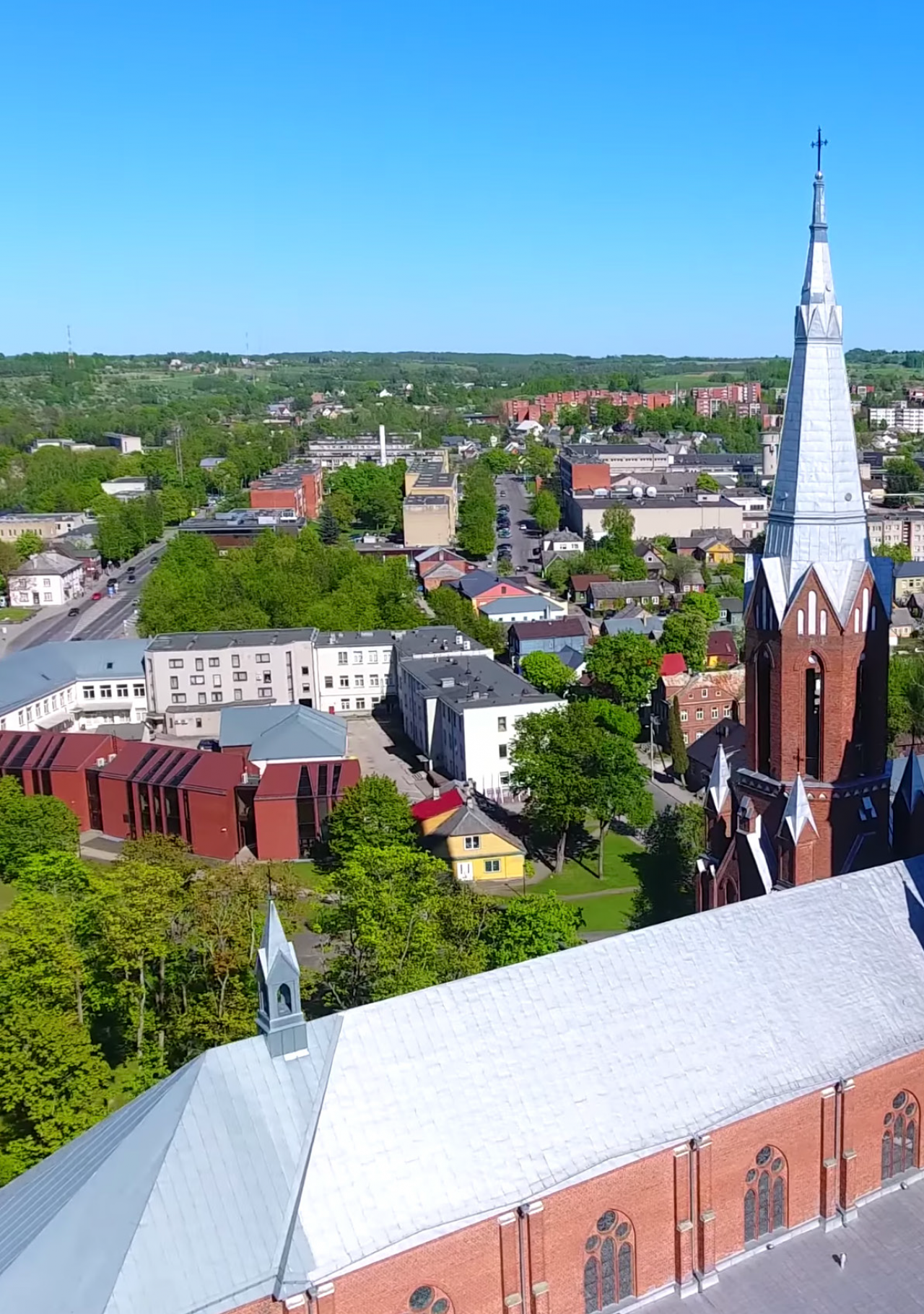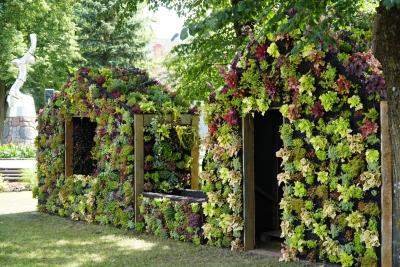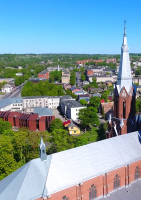
In 2019, the Municipality of Anykščiai District joined the URBACT “Healthy Cities” network. It was the first time the Municipality had become part of such an extensive network, intended for the acquaintance with the specific aspects of different countries, their issues, achievements and aspirations, as well as opportunities to gain valuable experience shared by all members and thus create a model of a Healthy City.
Striving for the status of a Resort as a trend of the strategic development scheme of Anykščiai, the Municipality had been working towards this vision for numerous years. However, its involvement in URBACT programme has highlighted the mistakes made in the attempt due to the insufficient inclusion of the community and the lack of analysis of the benefits for the public health. At the same time, the programme has confirmed the right choices made by the town of Anykščiai. It is vital to identify which type of a Resort we are striving for and decide if all of us approve of this vision, as well as determine if this will be more of a mere theoretical declaration or a direction based on practical actions. It is the tools and international partnerships offered by the network that, in this attempt, shape the broader views of Anykščiai helping to see it from a holistic perspective and searching for the common answers. This network has reassured that the chosen platform provides a new quality basis for the search and development of the Anykščiai phenomenon (Anykščiai – Healthy Through Culture) as well as the urban vision of the town, recharging the cultural schemes and launching a fresh start.
Contextual View and Work Done So Far
Anykščiai is a town located in the unique natural environment of which the distinction and value are created through the town’s history, and heritage, the high number of its outstanding figures, their fates and masterpieces created by them, their significance to the country and beyond its borders, the urban carcass of the town and its artistic signs. The whole territory of the town is included in the protected area, making part of the Anykščiai Regional Park. Part of the town belongs to the cultural heritage zone. The territory occupied by the town assumes an oblong shape with the river Šventoji, the town’s main artery and the living dominant landmark, running across its longitude. ![]()
2007 marked a turning point in the history of Anykščiai; the town was granted the status of a resort area, which encouraged the further searching for the true identity of the town. Over the past decade, the Municipality has participated in numerous projects of various kinds, has been provided funding by both European Union funds and the national and municipal budgets, and has implemented lots of projects of cultural heritage, nature and cultural tourism. Today, there is yet another project in progress which, being funded by EU Structural Funds, is also of utmost importance to the town centre and its gate. This project involves the restoration of the buildings once used by the local prominent figures, the urban planning and modelling of connections with other public objects). Soon, the Community Centre of Entrepreneurship will open its door to the public.
The network has made us realize that, regardless of the good efforts made through the implementation of the formerly conducted ecology-oriented projects, relying on the initiative launched by the local authorities alone, without the involvement of the community and the use of good practices shared by other countries, will make it impossible to clarify the value of the public objects, nor will it build the true connections among them, or develop a holistic concept of sustainable planning, or encourage the residents to use the available infrastructure with love. Therefore, we have started looking for new opportunities, fresh viewpoints and transformed understanding.
Town Centre – Bustling with Life and Devoted to People
The relic of the Soviet era – the non-functional, “untamed” main square of the town – had long been used only as a sacral space. The heated discussions about the future of the town centre and the efforts to bring it closer to the people urged for the measures to be taken, and, thus, 2020 saw successful implementation of experimental projects. To remind the activities people engaged themselves in before WWII in the centre of Anykščiai and the valuable pre-war urban view of the main square, we set up a mobile, small-scale service zone where tourists received information on the places to visit, could buy products made by local manufacturers, purchase books representing the literary treasures of Anykščiai region and enjoy a rest area. In midsummer, A. Baranauskas’ Square housed a unique design project, a live floral composition with a light installation – an allusion to the historic view of the Jewish quarters of the town. The unique memorial sign, never losing its liveliness throughout the year, has become a significant symbol of a green town, always bustling with life. This is a small-scale urban project. In the festive period of Christmas, the centre of Anykščiai was converted into a mysterious Forest twinkling with lights. Working along with the artists, we managed to create a particular mood for the central square, where every resident and guest could feel themselves surrounded by nature and sense nature dwelling in them. The plants, unique lighting and artistic installations – all exposed the harmony of the combination between the old and contemporary culture, as well as its subtle aesthetics.

We are extremely happy that through these measures, even under the complicated circumstances of the COVID-19 pandemic, the town centre has become “closer” to its residents, who have discovered it as a well-suited place for walking around with their families, or a safe free time zone. This way the central square has been turned into a project of macro urbanism.
Strategic Planning of Urban Areas in the Eyes of Professionals
Responding to the “Healthy Town Through Culture” trend, in September 2020, the administration of the Municipality of Anykščiai District held a creative workshop for urbanists, architects and landscape designers which was attended by professionals of these fields possessing international experience.
The subject of discussions chosen for the workshop dealt with the concept of urban development of Anykščiai. Having estimated the town’s history, structure and the occurring changes, the workshop participants sought ways how to make the most significant sites livelier and more attractive while paying tribute to the past and looking ahead at the same time. The participants identified the causes of the existing issues in order to provide solutions rather than combat the consequences. Some of the ideas expressed in the workshop are regarded as rather utopian. To implement them would primarily require shifting the people’s mindset as well as bringing up the unifying humanistic ideas and ensuring their systematic implementation. Today, the local community members clearly lack unifying purposes and aspirations. If the efforts to achieve success in the joint work were fruitful, it would spark enthusiasm, provide inspiration and encourage the further common action. Realizing that for all of this, a plan is needed, a concept has been generated.

At the end of September 2020, following the call for project proposals “Supporting Local Cultural Entrepreneurship” under the Culture programme of the European Economic Area Financial Mechanism 2014-2021, the Municipality submitted the concept of the central part of Anykščiai “The Experiments and Impulses of Cultural Entrepreneurship for the Centre of Anykščiai” and, having received a high-ranking evaluation, was invited to submit an application for this project in February 2021.
New Impulses and Opportunities: Discussing and Planning Ahead
Discussions with the Urbact Local Group, as well as the stakeholders and external experts assist in clarification of and provide recommended solutions to the identified problems through investigating them in different layers, all based on the current insights and analysis of the expectations as well as the information collected throughout the whole process. In the course of debating, it became clear that the central square of the town plays a vital role as the pivot of regeneration; so providing the square was successfully renovated, it would have a positive effect on the old town quarters and the town itself alike. It would instigate urban and architectural metabolism and open up the spaces and objects of change:

- development of the Anykščiai museum hill-complex as a literary museum of national importance – creating a centre of national and international cultural meetings via the renovation of A. Baranauskas and A. Vienuolis-Žukauskas Homestead Museum as an area intended for a cultural dialogue and dissemination of art;
- renaturalization of the slopes of the river valley within the territory of the town centre;
- modernization of the interior spaces of the public library by way of converting the backyards into yards adjusted for commerce and services – all open to the public;
- humanization of the concrete infrastructure (streets, bridges, etc.) through adoption of the sustainable urban mobility principles;
- conversion of the bus station into a multimodal centre by creating a terminal of the mobile centre;
- creation of an aromatherapy public park with a buvette of mineral water and different ecological zones;
- modelling the connections with visited places and objects.
It is essential that all of the afore mentioned goals become the contents of the Integrated action plan and transformation of Anykščiai. Our involvement in the network keeps us in motion as well as urges us to highlight the fundamental connections between culture and the holistic notion of health and search for comprehensive solutions.
Daiva Gasiūnienė,
Leader of Urbact Local Group
Head of the Department of Architecture and Urbanism (Administration of Anykščiai District Municipality)

